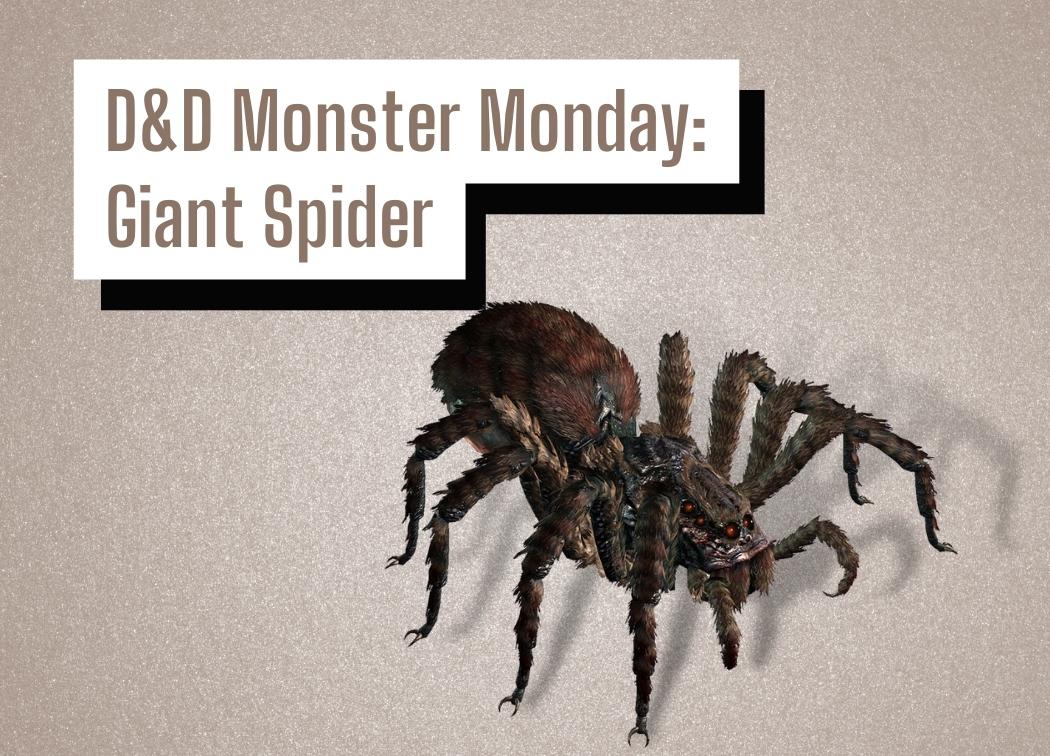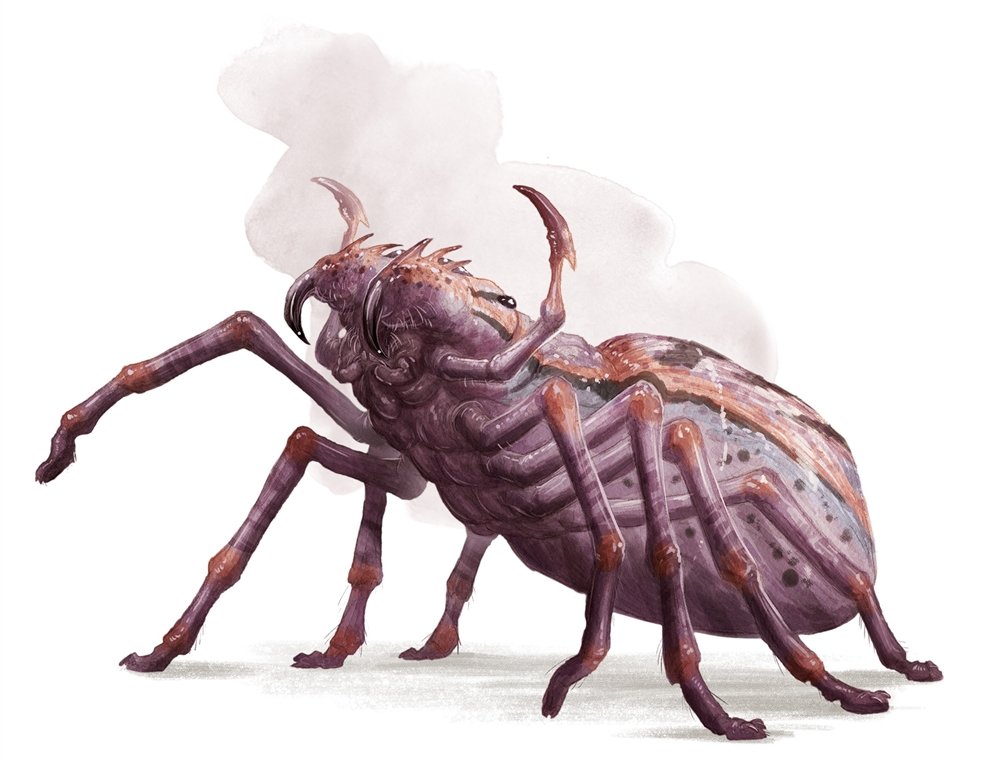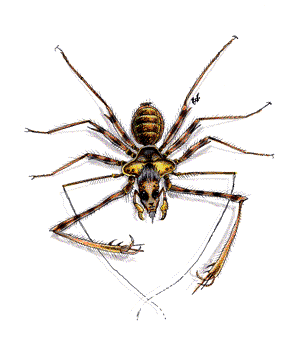D&D Monster Monday: Giant Spider

You’re awoken by the thunderous stomping of dozens of giant spiders skittering across the forest floor. Before you can draw your sword, a barrage of webbing smacks you in the chest, sticking you to a nearby tree trunk. Unable to break free of the thick webbing, you’ve resigned yourself to your fate – dinner.
It’s difficult to make a mechanically-interesting low-CR creature. After all, each feature or action that you add to a statblock to give a creature more options adds power to their kit. Ergo many classic low-CR creatures tend to be one-dimensional with a single attack action and maybe a unique trait or ability if they’re lucky.
The giant spider, however, breaks this mould. They’ve got a bunch of fun goodies to use that give them a variety of options in combat. They’re also quite versatile creatures and are found in a ton of different environments.
They’re a fantastic and thematic creature for low-tier adventures. After all, there’s nothing that will run a chill down your spine like being ambushed by a group of spiders!
Let’s cut our way through the thick webbing of the Monster Manual and take a look at these eight-legged terrors.

Giant Spider Lore
There’s not a whole lot to go off of here. I mean, they’re just a giant version of a regular spider.
They’re a creature that uses a sticky web to trap and envelope their prey. Then they slowly suck their insides out of their body. That’s creepy enough as-is, but at least where I’m from the spiders are a couple of inches large at most so I can deal with it.
Imagine if that same creature could fit into a 10×10 ft. square and instead of bugs and insects it caught full-grown people? That’s terrifying.
Then to add insult to injury, these bastards love to keep the corpse-filled cocoons of their past victims hanging from the ceiling of their lair as decorations.
Sure, giant spiders are just a bigger version of a normal spider, but that speaks volumes to how terrifying spiders are.
Giant Spider Stats and Abilities
You can find the giant spider’s statblock on page 328 of the Monster Manual.
Stats
Size: Large beast
AC: 14 (natural armor)
HP: 26 (4d10 + 4)
Speed: 30 ft., climb 30 ft.
STR: 14 (+2)
DEX: 16 (+3)
CON: 12 (+1)
INT: 2 (-4)
WIS: 11 (+0)
CHA: 4 (-3)
While the giant spider does have a pair of abysmal ability scores (INT & CHA), the rest of this section of their statblock is fantastic considering their CR 1 rating.
Beasts tend to have low AC and high HP. The giant spider isn’t an exception to this rule, but their 14 AC is above-average for low CR beasts. 26 HP isn’t amazing, but due to their unique movement and high CC, they’re able to compensate for their o.k. defenses.
Their ground speed is average, but the 30 ft. of climb speed is another boon to their statblock. Couple this with Web Walker and Spider Climb and you have some devastating maneuverability to work with.
Finally, the giant spider’s common saving throw abilities are respectable for a CR 1 creature. There are no negatives, but that +3 Dexterity modifier is a significant survivability boost with regards to DEX saves and AC.
Resistances, Immunities, Saves, and Skills
Skills: Stealth +7
Senses: blindsight 10 ft., darkvision 60 ft., passive Perception 10
Languages: —
CR: 1 (200 XP)
+7 to Stealth is huge. Coupled with Web Sense giant spiders have no issues using their webs to hide in the high corners of ceilings and waiting for the perfect opportunity to drop down on their unsuspecting prey.
Even with a net 0 Perception modifier, the giant spider still has decent senses. 60 ft. of darkvision and 10 ft. of blindsight allowing them to perceive their prey in a multitude of environments.
CR 1 is a fair classification for the giant spider. Their offensive capabilities hit well above CR 1, but once they’re cornered, their defenses are easy to cut through with pretty much anything aside from spells and abilities that call for Dexterity saving throws.
Traits and Abilities
Spider Climb. The spider can climb difficult surfaces, including upside down on ceilings, without needing to make an ability check.
Web Sense. While in contact with a web, the spider knows the exact location of any other creature in contact with the same web.
Web Walker. The spider ignores movement restrictions caused by webbing.
The Spider Climb and Web Walker combo have a ton of synergy to work with. I’ve used it and written about my results in detail before. Any corner, crevice, and surface of the battlefield are ripe for the picking.
Your spiders can traverse so many areas that the party’s melee combatants can’t even dream to reach, preventing a ton of damage.
Walking into a spider’s lair is a dangerous endeavor thanks to Web Sense. The spider(s) will know the party’s exact location without having to move around all that much. This allows them to bunker down and use their +7 Stealth modifier to ambush the party.
Actions
Bite. Melee Weapon Attack: +5 to hit, reach 5 ft., one creature. Hit: 7 (1d8 + 3) piercing damage, and the target must make a DC 11 Constitution saving throw, taking 9 (2d8) poison damage on a failed save, or half as much damage on a successful one. If the poison damage reduces the target to 0 hit points, the target is stable but poisoned for 1 hour, even after regaining hit points, and is paralyzed while poisoned in this way.
Web (Recharge 5–6). Ranged Weapon Attack:+5 to hit, range 30/60 ft., one creature. Hit: The target is restrained by webbing. As an action, the restrained target can make a DC 12 Strength check, bursting the webbing on a success. The webbing can also be attacked and destroyed (AC 10; hp 5; vulnerability to fire damage; immunity to bludgeoning, poison, and psychic damage).
The giant spider doesn’t have Multiattack. Ergo, its action economy is on-par with a low-level PC. However, their two distinct actions offer them some good variety to choose from in combat.
Bite is a two-pronged attack. The first is a standard attack with a respectable +5 to hit and an average of 7 piercing damage. During this attack the spider injects venom into the target, forcing them to make a DC 11 CON save or take an additional 9 average poison damage.
But wait, there’s more!
If the poison damage drops the target to 0 hp, they’re poisoned and paralyzed for 1 hour. Even if they’re healed. This could waste a ton of the party’s resources as it requires the fallen PC to be both healed and cured of the poison for them to return to normal.
Web is a mid-ranged rechargeable attack. Its range of 30/60 ft. isn’t amazing, but considering their fantastic mobility, the spider should have no issues hanging from a wall, ceiling, or web to safely get this attack off.
If the attack hits, the target is automatically restrained. Giving the spider and its allies advantage on attack rolls, and rooting the target in place while giving it disadvantage on attack rolls and DEX saves.
The only way for the target to break free of the webbing is for them or their allies to expend their action economy. The target can either pass a DC 12 Strength check or they or their friends can destroy the webbing. Neither of these conditions is difficult to bypass, but they’ll still require at least one wasted action to do so.
With a 1/3 chance of recharging this action, Web is a potent source of ranged crowd control (CC) in any fray.
Giant Spider Strengths
Tons of Damage
While they only get one Attack action per turn, the giant spider’s damage per round is very high. An average of 7 piercing damage is solid enough, but tack-on the potential 9 average poison damage and you have a whopping 16 average damage per bite.
That is sufficient to drop many level 1 or 2 PCs with a single chomp.
Keep in mind too that if the target is restrained thanks to an ally spider’s Web, the spider will have no issues biting into its prey.
Plentiful Mobility
30 ft. of climb speed by itself opens up a bunch of positioning options in combat. It adds a layer of verticality to the encounter. Especially when, thanks to Spider Climb, this includes walls and ceilings.
We must also consider the spiders’ lair. This room, dungeon, cave, etc. would be covered in webbing. Unless the party clears it, they’ll be trudging through difficult terrain, halving their speed.
This means, that the mobility gap increases by a significant margin since the spiders will have no issue thumping about in their web-filled lair, whilst the party trudges at a speed of 15 ft. per turn.

Potent Crowd Control
Web‘s ranged Restrain mechanic is a fantastic source of crowd control. It both hinders the target’s damage and movement capabilities while providing a boost to the spider and its allies whilst the target struggles in the webbing.
Plus it will require the party to use at least one action to unstick their comrade.
However, the spider has another source of crowd control thanks to the poison in its Bite. If they’re able to drop a target down to 0 HP with the poison damage, that target is effectively removed from the encounter unless the party heals them and cures the poison.
That’s a ton of resource and action economy expenditure.
Giant Spider Weaknesses
Susceptible to Ranged Foes
Giant spiders are a pain in the ass for any adventuring party, but they’re especially obnoxious for melee combatants to deal with. Their webs plant them to the ground, their webbed floors hinder their movement, and the spiders’ ability to sit on the ceiling outright removes the opportunity to attack them with melee weapons.
However, ranged PCs won’t have nearly as much of an issue. Sure, Web still hinders their damage output and mobility, but they can still shoot at the spiders using their preferred method of attack.
PCs with access to fire damage are a giant spider’s worst nightmare. Their flames will quickly get rid of any webbing and set their webbed allies free thanks to the webbing’s vulnerability to fire damage.
How to Play a Giant Spider
Use Those Legs!
Our 8-legged friends have an assortment of maneuverability tools at their disposal. It would be wise to use them to their fullest.
They have 30 ft. of speed as well as 30 ft. climb speed. So you’ve got a few positioning options outright, especially when you mix and match their speeds with their Web Walker and Spider Climb traits.
Creative usage of their climbing capabilities will help shore up the giant spider’s mediocre defenses. Position your spiders on the ceilings, atop large boulders, or up in a tree. Anywhere that the party’s melee combatants can’t reach.
In doing so, you’ll force them to use their suboptimal ranged weapons which in turn, lowers the party’s total damage per round.
Web First, Bite Last
Web is a potent CC option. It’s a mid-ranged weapon attack that has a 33% recharge rate so there’s little risk to using it whenever it’s available.
The ideal opener for your spider(s) is to web an available target. You have a couple of target options. You can either go in on a low-AC target so that they’ll be easier to kill while they’re Restrained by the webs, or you can target a high-AC/melee combatant to make them easier to hit and reduce their damage output.
Regardless, use Web as a way to reduce an enemy’s defenses, making them ripe for the picking. Your allies can focus their attacks on the target until either they’re downed, or broken free of their restraints.
If you have multiple giant spiders in an encounter, rotate their Web attacks to ensure that there’s always at least one target restrained at all times.
5 Giant Spider Plot Hooks
- A Missing Party –A young group of adventurers embarked on a quest three weeks ago but never returned. The mother of the fighter has offered a reward for their safe return or news of their whereabouts.
- Cocoons in the Forest – You spot a dozen cocoons hanging from a cluster of trees not far from the well-guarded path you’re traveling on. Upon closer inspection, the cocoons have been there for some time.
- We’re Gonna Need a Bigger Boot – After the tavernkeep’s month-long vacation, they came back to find their basement storeroom full of thick, enormous, spider webbing.
- War in the Mines – An abandoned mine shaft was once occupied by a band of kobolds. A few weeks ago, however, a turf war began once a swarm of spiders descended upon the mines. Chaos and bloodshed has made the surrounding area, including the roads, very dangerous.
- Spider Rancher – You come across a lone farmstead. At first glance, it appears to be abandoned as there are no farm animals or crops growing. A strange old farmer emerges from a pitch-black farmhouse. He looks surprised, yet enthused to have visitors.
Conclusions
The giant spider is a low-CR creature with a surprising amount of tools in its kit. They’re quite fun to pilot which is a welcome departure from the typical simplistic statblocks that low-CR creatures tend to have.
The simplicity of their lore also makes them versatile for slotting into any adventure. You can find a giant spider in a plethora of locales without needing to spend much time justifying why they’d be there.
They’re terrifying for a low-level party to encounter, fun to use, and easy to slot into any campaign. Giant spiders are perfect low-CR creatures to throw into any DM’s arsenal.
